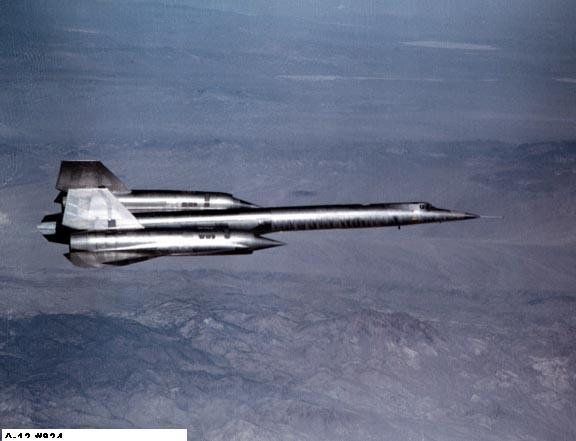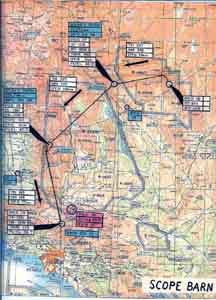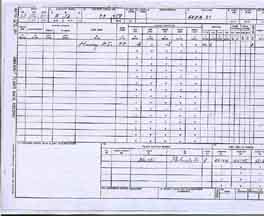


 |
 |
 |
 The Black Shield pilots were briefed on the demise of the OXCART Program a few months before the actual shutdown of operations at the Kadena Detachment where three A-12's were being kept as backup resources should the SR-71 not make its
The Black Shield pilots were briefed on the demise of the OXCART Program a few months before the actual shutdown of operations at the Kadena Detachment where three A-12's were being kept as backup resources should the SR-71 not make its  debut as advertised. Though the A-12's did backup the SR-71 missions, none were required to actually fly another mission. With about a month to go at Kadena, the A-12's were being prepped for their return to Area 51 and onto storage at the Lockheed Site 2 on Palmdale.
debut as advertised. Though the A-12's did backup the SR-71 missions, none were required to actually fly another mission. With about a month to go at Kadena, the A-12's were being prepped for their return to Area 51 and onto storage at the Lockheed Site 2 on Palmdale.
At the beginning of June 1968, the final month before retirement of the A-12s, Jack Weeks and Frank Murray were the duty pilots at the detachment in Kadena. While awaiting the order to relocate, the three A-12's were being flown about once a week to provide currency for the pilots and to exercise the airplanes.
Each of the A-12's was given a thorough final test flight to be ensure its readiness for the flight over the Pacific to the home base at Area 51. A-12 06932, Article 129 as it was called by Lockheed was scheduled for it's functional check flight (FCF) on 3 June 1968. Frank Murray flew the FCF along the usual test hop route to the South of Kadena with a sweeping turn back to the North near the big island of the Philippines. During his flight Murray discovered some problems with the scheduling of the internal bypass routine of the engine, leading to a flameout of the right engine on descent back into Kadena. The difficulty with the engine was thought best solved by changing out the right engine with a "good" known engine kept at Kadena as a spare mission engine. The engine was changed, and Jack Weeks was scheduled to fly another FCF on 5 June 1968.
Weeks' mission started off with a top-off refueling, then the test hop route dictated by weather conditions. The climb-out and start of the turn back North apparently went as planned. Then the on-board telemetry system (Birdwatcher) started sending downlinks indicating the right engine was overtemping, followed by low fuel flow signals and finally that the altitude was below 70,000? approximately. Then all signals from Article 129 ceased and it was presumed that the airplane was down. Intensive searches failed to show any sign of the airplane or its pilot. The ensuing accident board concluded that the most likely cause of the loss of the airplane was catastrophic failure of the right engine. About this time, Article 127 and Article 131 were test flown and readied for ferry back to Area 51. Two other A-12 pilots, Ken Collins and Dennis Sullivan were sent to Kadena to help with the ferry flights.
Dennis Sullivan flew Article 127 back to Area in record time without incident. Article 131 was another story.
Article 131 was readied like the other A-12's with a FCF, then it was to go home post haste----------WRONG--------
 Ken Collins remembers starting off for home with a top-off tanking near Iwo Jima, then the route went by Wake Island, Hawaii and on to home. . .but 131 had problems along the way. Between the top-off tanker and Wake Island, a fuel leak developed in the right engine nacelle. The leak was noted by an abnormally high fuel flow and was visible through the canopy periscope, so Ken landed at Wake Island, rather than the planned inflight refueling nearby.
Ken Collins remembers starting off for home with a top-off tanking near Iwo Jima, then the route went by Wake Island, Hawaii and on to home. . .but 131 had problems along the way. Between the top-off tanker and Wake Island, a fuel leak developed in the right engine nacelle. The leak was noted by an abnormally high fuel flow and was visible through the canopy periscope, so Ken landed at Wake Island, rather than the planned inflight refueling nearby.
A recovery crew was dispatched to fix the leak and get the Article on to Hickam Air Base in Hawaii, where it could be fully serviced. It took several days for the recovery team to affect the repairs. Ken then flew 131 low and slow with a tanker to top off his tanks from time to time and made it to Hickam safely. Ken left to head for the mainland to attend Jack Weeks memorial service while Frank Murray stayed with 131 being serviced for a high and fast return flight.
After the refueling near Hawaii on the first attempt to go home 131 developed the fuel leak from the same part of the engine fuel system. Frank dumped fuel and returned to Hickam. The crew once again replaced the broken fuel manifold and Frank once again headed home with the usual top-off tanking. On the climb-out from the tanker, the same thing happened, bad fuel leak from the same side.
This time the recovery crew took extraordinary steps to get the A-12 ready. After repairing the fuel leak they installed vibration sensors for the ground run and discovered that the airframe mount accessory drive (AMAD) was unbalanced and required change-out. This took several days to do, so Frank lounged around Oahu, enjoying the sights. On the third attempt to leave Hickam, the airplane performed normally so Frank headed home to Area 51. On the way the Exhaust Gas Temperature gauge for the right engine failed to zero, but that was no reason to abort. Frank matched the engine control for the right engine with those of the left engine and finished off the flight . . . FINALLY. . . .
When Frank landed at the Area, Article 131 had the base to itself, the other A-12's having already been flown to Palmdale for storage. The ground crew at the Area removed the mission equipment from 131 and prepped it for the short flight to Palmdale two days after landing from the Hickam debacle.
Major Willie Wuest had something to say about this event as well. From his book of poems:
The Fast Trip
When Denny rushed across Lake Mead in five plus twenty nine,
All hopes sank for Ken and Frank, no broken record time.
But nothing daunted, this wily pair conspired to save the day,
And with great skill and cunning, broke a record Anyway.
Eleven days and forty minutes they took to make the trip.
The slowest of all records lies firmly in their grip.
This surely is a record they will keep to the judgment day,
For no one, not even Admiral Hayes, would WANT to TAKE IT AWAY!!!
****The Final Flight of the A-12****
The earlier A-12's were ferried to Palmdale in the dark early morning hours to not be noticed by the public. The morning of 21 June 1968 Frank Murray was scheduled to fly Article 131, the last A-12, to Palmdale to join the others in retirement. Frank considered this to be a singular honor even though one might say he won the honor by default since he was the only A-12 pilot left at the Area. To him this was both a happy day and a sad one. He was happy to be the guy to fly the last flight and sad to see the end of the OXCART Program.
The Final Briefing:
The briefing was done about 0400 on the morning of 21 June 1968. Most personnel at Area 51 at this time of day were asleep, but as usual there were some working these hours to get things done, like launching the final A-12 mission. The mission was short with routing more or less over unpopulated areas, and to flown at subsonic speeds to prevent "booming" folks along the way. (see Pilots hand Map).
there were some working these hours to get things done, like launching the final A-12 mission. The mission was short with routing more or less over unpopulated areas, and to flown at subsonic speeds to prevent "booming" folks along the way. (see Pilots hand Map).
The weather officer on duty for this briefing was none other then Major Willie Wuest - The Bard of Beatty. He wrote another of his fabulous oldies, appropriate for this occasion. In the words of the Bard himself!!
Composed and read at that tragic and historic occasion, the Final Scope Barn, 21 June 1968, in the Fifth Year of the Great Society.
With infinite skill and loving care And a sad and heavy heart, The weather man in the early Morn Drew his final weather chart. He lovingly sketched each isobar Over land and sea and shore, As he had done so many times For the last eight years or more. He entered weather symbols Each in its proper place, As emotion overcame him And tears streamed down his face. His voice so choked with sorrow You could barely hear him say ?This briefing chart is all screwed up, It CAVU all the way!!!? |
After the Final Briefing, Frank stopped by the Command Post to bid farewell to the Duty Crew. It was there that Frank picked up the miniature A-12 metal marker the CP people used to mark the position of a particular A-12 flying out of the local area. This marker has the number 131 engraved on it.
Then it was off to the Personal Equipment room to don the pressure suit for the flight to Palmdale with farewells to the technicians who performed suit up of the pilot and checkout of his systems before flight. Most of these technicians are from the maker of the suits, the David Clark Company. With the suit checking OK, it time to ride the Crew Bus down to the hangar where 131 is awaiting. Again, Frank paid farewells to the launch crewmen and the assembled few people there to see the final Launch.
The sound of the Buicks on the start cart still sounded like music, there was no sound like the roar of those engines as they turn the J-58 to start speed.
It was still dark on the taxi-out to Runway 32 where the runway launch crew chocked the A-12 for the pre-launch run-up. No chase on this final flight.
After takeoff, Frank made a right turn to the Northeast and climbed up to about 40,000, where he turned back towards the Area, accelerating in  AB to supersonic, leaving a wake-up call for the sleepy heads not involved with the Final Flight. He decel'd and took up the INS route to Palmdale, checking in with Salt Lake Center as he flew to Palmdale at about 30,000' altitude. Descending enroute to the field at Palmdale, he checked with the Tower for landing instructions.
AB to supersonic, leaving a wake-up call for the sleepy heads not involved with the Final Flight. He decel'd and took up the INS route to Palmdale, checking in with Salt Lake Center as he flew to Palmdale at about 30,000' altitude. Descending enroute to the field at Palmdale, he checked with the Tower for landing instructions.
The other Project Pilots and their families, along with Sharlene Weeks and her family were allowed to view the Final Flight and recovery into the storage area at Lockheed Site 2. Frank made a couple flybys, one with a climb with afterburner after a low approach. This was the first and only time the family member saw the A-12 in flight. One of Frank's daughters missed the event since she was away at Girl Scout camp.
After landing Frank taxied to the area where the families were assembled, then shut down Article 131 for the last time. See AFTO 781, Aircraft Flight Data Record, for the Final Flight time details.
After exiting the aircraft and unsuiting, Frank joined the assembled families for a drive to the Antelope Valley Inn for breakfast.
The Final Flight was complete; the Pilots rejoined the Air Force shortly and so ended one of the finest flying organizations put together by the CIA.
 |
 |
 |